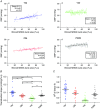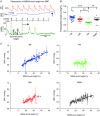Quantifying sympathetic neuro-haemodynamic transduction at rest in humans: insights into sex, ageing and blood pressure control
- PMID: 27068560
- PMCID: PMC5009776
- DOI: 10.1113/JP272167
Quantifying sympathetic neuro-haemodynamic transduction at rest in humans: insights into sex, ageing and blood pressure control
Abstract
Key points: We have developed a simple analytical method for quantifying the transduction of sympathetic activity into vascular tone. This method demonstrates that as women age, the transfer of sympathetic nerve activity into vascular tone is increased, so that for a given level of sympathetic activity there is more vasoconstriction. In men, this measure decreases with age. Test-re-test analysis demonstrated that the new method is a reliable estimate of sympathetic transduction. We conclude that increased sympathetic vascular coupling contributes to the age-related increase in blood pressure that occurs in women only. This measure is a reliable estimate of sympathetic transduction in populations with high sympathetic nerve activity. Thus, it will provide information regarding whether treatment targeting the sympathetic nervous system, which interrupts the transfer of sympathetic nerve activity into vascular tone, will be effective in reducing blood pressure in hypertensive patients. This may provide insight into which populations will respond to certain types of anti-hypertensive medication.
Abstract: Sex and age differences in the sympathetic control of resting blood pressure (BP) may be due to differences in the transduction of sympathetic nerve activity (SNA) into vascular tone. Current methods for dynamically quantifying transduction focus on the relationship between SNA and vasoconstriction during a pressor stimulus, which increases BP and may be contra-indicated in patients. We describe a simple analytical method for quantifying transduction under resting conditions. We performed linear regression analysis of binned muscle SNA burst areas against diastolic BP (DBP). We assessed whether the slope of this relationship reflects the transduction of SNA into DBP. To evaluate this, we investigated whether this measure captures differences in transduction in different populations. Specifically, we (1) quantified transduction in young men (YM), young women (YW), older men (OM) and postmenopausal women (PMW); and (2) measured changes in transduction during β-blockade using propranolol in YW, YM and PMW. YM had a greater transduction vs. OM (0.10 ± 0.01 mmHg (% s)(-1) , n = 23 vs. 0.06 ± 0.01 mmHg (% s)(-1) , n = 18; P = 0.003). Transduction was lowest in YW (0.02 ± 0.01 mmHg (% s)(-1) , n = 23) and increased during β-blockade (0.11 ± 0.01 mmHg (% s)(-1) ; P < 0.001). Transduction in PMW (0.07 ± 0.01 mmHg (% s)(-1) , n = 23) was greater compared to YW (P = 0.001), and was not altered during β-blockade (0.06 ± 0.01 mmHg (% s)(-1) ; P = 0.98). Importantly, transduction increased in women with age, but decreased in men. Transduction in women intersected that in men at 55 ± 1.5 years. This measure of transduction captures age- and sex-differences in the sympathetic regulation of DBP and may be valuable in quantifying transduction in disease. In particular, this measure may help target treatment strategies in specific hypertensive subpopulations.
© 2016 The Authors. The Journal of Physiology © 2016 The Physiological Society.
Figures








Comment in
-
Sympathetic nerve activity and blood pressure: who leads, who follows and why sex matters.J Physiol. 2016 Sep 1;594(17):4705-6. doi: 10.1113/JP272569. J Physiol. 2016. PMID: 27581565 Free PMC article. No abstract available.
-
Methodological assessment of sympathetic vascular transduction.J Physiol. 2016 Dec 1;594(23):6809-6810. doi: 10.1113/JP273436. J Physiol. 2016. PMID: 27905131 Free PMC article. No abstract available.
References
-
- Bell C, Seals DR, Monroe MB, Day DS, Shapiro LF, Johnson DG & Jones PP (2001). Tonic sympathetic support of metabolic rate is attenuated with age, sedentary lifestyle, and female sex in healthy adults. J Clin Endocrinol Metab 86, 4440–4444. - PubMed
-
- Blessing WW (1997). The Lower Brainstem and Bodily Homeostasis, pp. 165–268. Oxford University Press, New York.
-
- Burnstock G (2008). Non‐synaptic transmission at autonomic neuroeffector junctions. Neurochem Int 52, 14–25. - PubMed
-
- Burnstock G (2009). Purinergic cotransmission. Exp Physiol 94, 20–24. - PubMed
Publication types
MeSH terms
Substances
Grants and funding
LinkOut - more resources
Full Text Sources
Other Literature Sources
Medical
Research Materials

